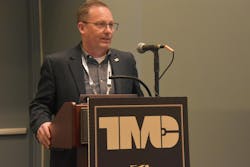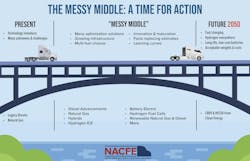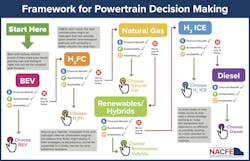NACFE offers industry road map through 'Messy Middle'
NASHVILLE—The good news is that fleets have more options than ever when spec’ing the right equipment and technology for the application and efficiency targets. The downside, however, is increasing confusion in the marketplace, explained Mike Roeth, executive director for the North American Council for Freight Efficiency.
“I'd like to congratulate the industry, but they've certainly helped us create a mess,” Roeth said, speaking during a press conference at the American Trucking Associations Technology & Maintenance Council Annual Meeting & Transportation Technology Exhibition here. “I worry that we're creating too many solutions. We're hitting a saturation point where we, as an industry, may not be able to handle all these options.”
NACFE has released a white paper, Navigating the Messy Middle: The Move to More Sustainable Trucking, to make sense of it all.
Recognizing that all the powertrain solutions currently available to fleets can make it challenging to determine which solution best suits a fleet’s operation, NACFE published a white paper that provides deeper insight into the term Messy Middle.
“I liken the Messy Middle to a smorgasbord where fleets have a wide variety of options,” Roeth said. “It can seem like an overwhelming number of choices, and we wrote this white paper to bring some clarity to the current situation.”
See also: Roeth: Join our 'messy' dialogues about your fleet's future
NACFE began using the term Messy Middle in 2018 to describe the time between now and when trucking reaches a zero-emission future.
However, the new whitepaper goes beyond identifying the various options. It also delves a little deeper into the terminology.
“We have received a good deal of feedback on the idea since introducing [Messy Middle] in 2018. Much of it good and some questioning our declaring it a mess. While I don’t think many of us love being in a mess, we don’t always select the situations we find ourselves in,” Roeth said. “We don’t think messy is necessarily bad. In fact, messy can be good because it implies a variety of options available for fleets to choose from.”
In addition to defining the Messy Middle, the white paper briefly overviews the various powertrain options available to fleets today.
The key is to choose the right powertrain for the application.
“We maintain a fleet of more than 450,000 vehicles and are always looking at ways to optimize our assets,” Paul Rosa, SVP of procurement and fleet for Penske, said. “We are constantly evaluating powertrain options to determine which make sense for each of our Class 2b to 8 commercial vehicle duty cycles. NACFE’s work on defining the Messy Middle and laying out a framework for evaluating the various options should help fleets have a better understanding of which powertrain solutions will work for them.”
Penske is No. 16 on the 2025 FleetOwner 500: For-Hire list.
The paper also explains the factors that must be considered when choosing a powertrain solution and provides a helpful framework in the decision-making process.
“This paper, along with the previously published A Need to Redefine Class 8 Long-Haul Trucking, are part of our Run on Less–Messy Middle efforts, which also includes a bootcamp, and will feature profiles of participating fleets and a dashboard of metrics from the fleets’ operations. All of these efforts are designed to help bring clarity to long-haul trucking,” Roeth said.
Roeth noted a fleet using hydrogen fuel cell trucks from the recently failed Nikola Corp. is participating in the Messy Middle study, and Nikola’s rapid rise and fall is emblematic of the race to develop new technologies in the trucking space.
“Was it a bad idea or is it a good idea, just too early? Or is it a good idea mishandled?” Roeth said, referring to the Nikola vehicles. “The industry is complex already, with different kinds of duty cycles and so forth—but we’ve always had diesel and diesel engines. Our future is not passive. This is our new world and you can be part of it, or go do something else.”
About the Author
Kevin Jones
Editor
Kevin has served as editor-in-chief of Trailer/Body Builders magazine since 2017—just the third editor in the magazine’s 60 years. He is also editorial director for Endeavor Business Media’s Commercial Vehicle group, which includes FleetOwner, Bulk Transporter, Refrigerated Transporter, American Trucker, and Fleet Maintenance magazines and websites.
Working from Beaufort, S.C., Kevin has covered trucking and manufacturing for nearly 20 years. His writing and commentary about the trucking industry and, previously, business and government, has been recognized with numerous state, regional, and national journalism awards.



